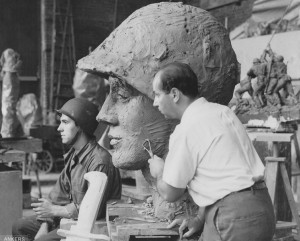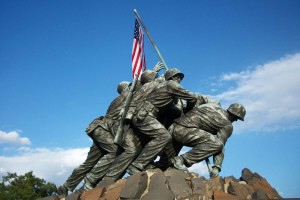08 Nov Sculpting the Marine Corps War Memorial

Sculptor Felix de Weldon creating the face of Marine Rene A. Gagnon. (from the collection of John Paul Howard.)
This week I had the opportunity to interview a veteran who will be coming with us on Roswell Rotary’s 8th Honor Air trip, just scheduled for May 16, 2016. This is our opportunity to honor WWII, Korean and Vietnam War veterans with a day trip to Washington, D.C. at absolutely no cost to them.
John “Paul” Howard served in the Navy during the Korean War. His first assignment was pilot training in Pensacola, however he was color blind so that was not to be. Eventually Paul was sent to the Navy Photographic Labs in Washington, D.C. where he worked on lighting for motion pictures being made there. This required a top secret security clearance due to the work being done there and the people who just happened to be walking through. Paul met Admiral Chester W. Nimitz as well as other top Admirals and dignitaries.
He also met the sculptor of the statue of the famous raising of the flag on Iwo Jima, now the Marine Corps War Memorial. This photo is from Paul’s wartime collection.
On February 23, 1945, Marines of Company E, 2nd Battalion, climbed to the top of Mount Suribachi on the tiny island of Iwo Jima. That afternoon, five Marines and a Navy hospital corpsman raised a large American flag. At just the right moment, Joe Rosenthal of the Associated Press snapped his camera. This image won a Pulitzer Prize and became possibly the most moving and recognizable photograph of the war.
Sculptor Felix de Weldon, then on duty with the US Navy, constructed a scale model and then in 1951 began a life-size model of the photograph. The three survivors of the flag raising, Marines Rene Gagnon and Ira Hayes as well as Navy corpsman John Bradley, posed for the sculptor as he modeled their faces in clay. Photographs and physical measurements were used for the two men, Marines Michael Strank and Harlon Block, who had died on Iwo Jima.
President Dwight D. Eisenhower dedicated the memorial on November 10, 1954, the 179th anniversary of the U.S. Marine Corps.
On each of our Honor Air trips, on our way to Arlington National Cemetery our buses stop at the Marine Corps War Memorial. Marine veterans on board usually step out to walk up close. Inscribed around the polished black base are the dates and locations of every Corps major action up to the present time.
The story of the battle and the flag raising was written by James Bradley, the son of flag raiser John Bradley. His book, Flags of Our Fathers, was published in 2000, then made into a movie in 2006 by Clint Eastwood.
Thank you, John Paul Howard, for your photograph and for the great memories of your years in the Navy.



No Comments